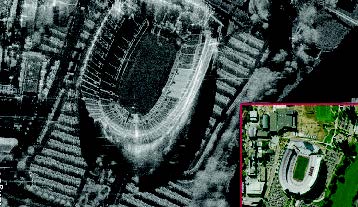General Dynamics created this high-resolution synthetic aperture radar image of Ohio Stadium. The SSHToolbox provides the capability for AFRL/SN researchers to routinely generate similar quality images using both high performance computing and a custom MATLAB GUI designed by OSC researchers.
A key element in enabling customers to use high performance computing technology is the ability to access supercomputing systems in a simple, straightforward manner.
Many U.S. Department of Defense (DoD) high performance computing researchers, particularly those in the Signal Image Processing (SIP) area, develop and run programming codes with MATLAB or related development tools such as MatlabMPI, StarP, and pMatlab. These development tools are convenient because they are completely self-contained on a desktop computer.
When MATLAB researchers need access to supercomputers, they desire to connect to and interact with the high performance computers but are reluctant to leave their comfortable desktop MATLAB environment. Often they choose not to use HPC resources because the loss of productivity is too expensive.
With the SSHToolbox, OSC experts have empowered users to be able to have the best of both worlds. SSH stands for Secure Shell and is the most widely used protocol/tool for connecting to remote high performance computing resources. The toolbox supports the DoD-mandated Kerberized authentication protocol and is used for interacting with DoD, government, industry, and systems. Customers include Boeing, NASA, the Pentagon, Air Force, Army, Navy, and universities.
“The toolbox provides simple commands for users to connect to a remote system, run code, send and retrieve results, and disconnect,” said John Nehrbass, technical fellow/director of SIP, Ohio Supercomputer Center. “In essence, the SSHToolbox allows a complicated HPC application to be implemented so that it is as easy to use as clicking a mouse.”
Since the main component of the toolbox is written in C and packaged as a dynamic link library (DLL), the toolbox also can be extended to work with other programming languages such as Java, Python, and Octave. The complexity of the DLL interface and most of the security needs are hidden from the user, making this a very easy to use and powerful toolbox. MATLAB-style documentation for the toolbox also makes it easy to obtain help on various aspects of the toolbox, and a GUI-based installer enables distribution.
--
Lead Researcher:
John Nehrbass, Ph.D., Ohio Supercomputer Center
OSC Project Team:
• Siddharth Samsi
• Tanner Suttles
• Ben Smith
• Stan Ahalt, Ph.D.
• Ashok Krishnamurthy, Ph.D.
• Alan Chalker, Ph.D.
• Juan Carlos Chaves, Ph.D.
• Judy Gardiner, Ph.D.
• Brian Guilfoos
• Jose Unpingco, Ph.D.
Research Title:
Interfacing PC-based MATLAB Directly to HPC Resources
Funding Source:
U.S. Department of Defense, High Performance Computing Modernization Program User Productivity Enhancement and Technology Transfer (HPCMP PET)
